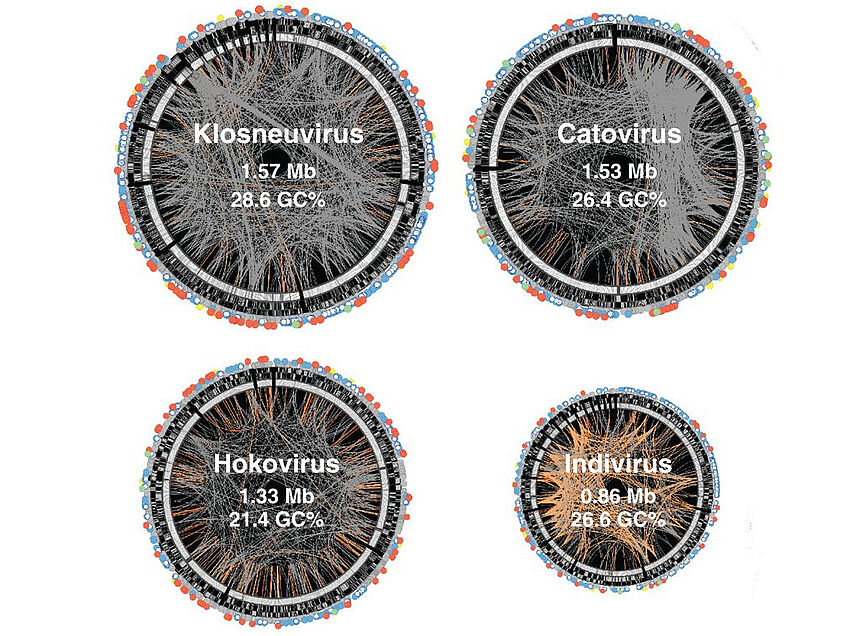Giant viruses: Evolution, adaptation and population dynamics
A schematic representing the genome architecture and gene content of the Klosneuviruses. Adapted from Schulz et al 2017.
Viruses are the most abundant biological entities infecting all cellular life forms with major consequences for their individual hosts and entire ecosystems. Yet, they are also the most unknown biological players, with the protist-infecting nucleocytoplasmic large DNA viruses (Nucleocytoviricota), also referred to as giant viruses, as one of the more recent discoveries that challenged our perception of the viral world.
Giant viruses are as large as bacteria both in terms of particle and genome size, and share a number of features previously observed in cellular microorganisms only. Our current knowledge about these unusual viruses is predominantly based on few isolates obtained with a very limited number of protist host species, while metagenomic data suggests a tremendous diversity of yet undiscovered viruses infecting microbial eukaryotes.
We participated in the discovery of the Klosneuvirinae, a group of giant viruses with a record-holding large number of translation-related genes. More recently, we have shown how bacterial symbionts help amoeba hosts to counter infections by giant viruses, representing one of the very few giant virus defense mechanisms in protists.
Recent projects: Giant viruses in the wild
To further uncover giant virus diversity, we use targeted co-cultivation with alternative protist hosts for the isolation of new giant viruses. This is complemented by targeted enrichment of heterotrophic protists and giant viruses directly from environmental samples and subsequent metagenomics and mini-metagenomics analyses. We also study giant viruses using experimental evolution approaches, and we use time series data and microcosm experiments to investigate giant viruses and their hosts in complex microbial communities.
This research is funded by the Austrian Science Fund FWF (grant DOI 10.55776/P37198) and carried out within the groups of Matthias Horn and Anouk Willemsen.
Selected publications on this theme:
- Arthofer P, Panhölzl F, Delafont V, Hay A, Reipert S, Cyran N, Stefanie Wienkoop, Anouk Willemsen, Ines Sifaoui, Iñigo Arberas-Jiménez, Frederik Schulz, Jacob Lorenzo-Morales, Matthias Horn. 2024. A giant virus infecting the amoeboflagellate Naegleria. Nature Communications, 15:3307. http://dx.doi.org/10.1038/s41467-024-47308-2
- Arthofer P, Delafont V, Willemsen A, Panhölzl F, Horn M. 2022. Defensive symbiosis against giant viruses in amoebae. PNAS, 119: e2205856119. http://dx.doi.org/10.1073/pnas.2205856119
- Schulz F, Yutin N, Ivanova NN, Ortega DR, Lee TK, Vierheilig J, Daims H, Horn M, Wagner M, Jensen GJ, Kyrpides NC, Koonin EV, Woyke T. 2017. Giant viruses with an expanded complement of translation system components. Science, 6333: 82-85. http://dx.doi.org/10.1126/science.aal4657

